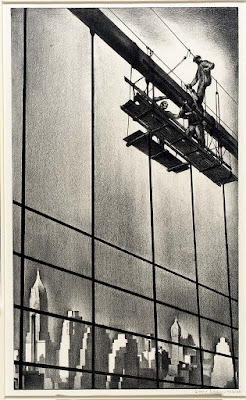Happy Birthday Louis Lozowick (December 10, 1892 – September 9, 1973)
by Samuel D. Gruber
Today is the birthday of American-Jewish artist Louis Lozowick, one of my favorite artists of the dynamic energy of the American city. Lozowick, who born in the Ludvinovka, Ukraine in 1892, came to the United States as an undocumented still-young art student in 1906. He studied art and graduated from college here, and served in the military before going back to Europe to spend time engaged with the avant-garde art movements of the interwar years. In Paris he was influenced by Leger and Gris, and he learned lithography in Berlin. He was especially influence by El Lissitzky and Russian Constructivism (as can be seen in his 1928 cover for New Masses, below). Back in America he became best known for his socially relevant art in New Masses and and then his bold black-and-white cityscapes that captured the stark geometry, steep angles and deep shadows of the new skyscraper city.
He loved depicting the engineering of the construction and the intricacy and mystery of machines and today Lozowick is best known for his lithographs of skyscrapers and machinery. But his output was quite varied. He was a consummate draftsman and craftsman, but he also had an eye for the unusual arrangement and incongruous juxtaposition. I'm sure his work influenced many American film noir directors, cinematographers and editors.
Unlike many of his Jewish contemporaries (like Raphael Soyer) Lozowick had no problem with being identified as a Jewish artist. But he said "there can be Jewish artists but no Jewish art, unless there be a social need for it," (Menorah Journal, July 1924). He was willing to exhibit in Jewish venues and publish in Jeiwhs cultural periodicals. But he considered his themes and styles contemporary and universal.
Many art historians have looked at Lozowick's work as part of studies from varied perspectives and as part of different groups or genres (urban, radical, Jewish, New York school, graphics, murals, etc.) but rarely has the spread of his career been considered. Today. Lozowick has the distinction - perhaps with another contemproary Max Weber, a being a little-known 20th-century great. A major exhibition of Lozowick's is overdue.Maybe in 2023 on the 50th anniversary of this death? Or why not sooner?
For a good sampling of his graphic work see here.
And even more work here.
Here is a biographical information from the Syracuse University Library where a few linear feet of papers relating to his life and career can be found.Much more material is held by the Smithsonian (see the fining aid here).
"He attended the Kiev Art School from 1904 to 1906 and emigrated to the United States
at age 14 -- a tricky achievement since he came without passport or papers. Once
in New York he took a series of factory jobs to pay for his art studies at the National
Academy of Design (1912-1915) with Carlson, Leon Kroll, and others. In 1915 he entered
Ohio State University, graduating in three years as a Phi Beta Kappa. In 1919, after
a brief stint in the military, he left the United States to travel extensively throughout
Europe, studying art and supporting himself by writing articles for various European
publications.
Almost immediately upon his return to the United States, he began his "Machine Ornament"
series, exploring the straight lines, contrasting light and shadow, and geometrical
patterns of the urban landscape that would fascinate him for the next fifty years.
In 1924 he had an exhibit at the New Art Circle and then another at Weyhe's; both
Weyhe and Carl Zigrosser, then head of the gallery, encouraged Lozowick in his focus
on the graphic arts. The young artist had a number of exhibits of his lithographs
over the next few years at Weyhe's and at Whitney Studio on West 8th Street including
his "Machine Age Exposition" in 1927. Throughout his career the complex architecture
of the urban landscape -- bridges, scaffolding, train tracks, skyscrapers -- continued
to intrigue him (though nature appears more frequently in pieces from his later years).
During the Depression Lozowick, like many of his fellow artists, created murals and prints for the WPA including a mural for the New York City General Post Office (1936). In 1931 he married Adele Turner, and in 1943 the couple moved to New Jersey where Lozowick remained for the rest of his career"







No comments:
Post a Comment